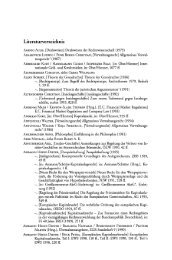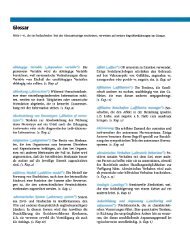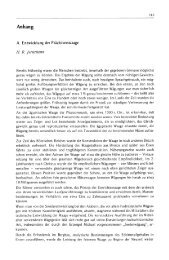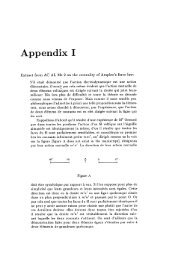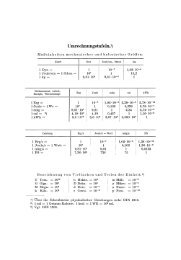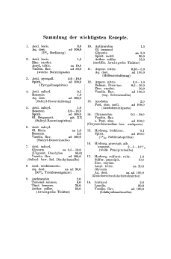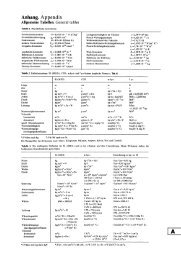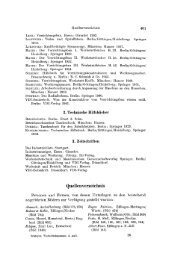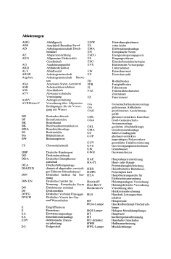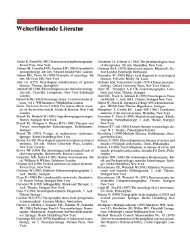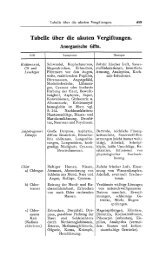Download PDF (207KB) - Springer
Download PDF (207KB) - Springer
Download PDF (207KB) - Springer
You also want an ePaper? Increase the reach of your titles
YUMPU automatically turns print PDFs into web optimized ePapers that Google loves.
A<br />
Anhang<br />
Literatur – 231<br />
Quellenverzeichnis – 241<br />
Stichwortverzeichnis – 245
231<br />
Literatur<br />
Ackerman, D. (1991). Die schöne Macht der Sinne. Eine Kulturgeschichte. München: Kindler.<br />
Ahissar, M (2001). Perceptual training: A tool for both modifying the brain and exploring it. Proceedings of<br />
the National Academy of Sciences, 98, 11842–11843.<br />
Ahissar, M. & Hochstein, S. (1997). Task difficulty and learning specificity: Reverse hierarchies in sensory<br />
processing and perceptual learning. Nature, 387, 401–406.<br />
Aristoteles – De Anima. Hrsg.: Seidl, H. (1995). Hamburg: Meiner Verlag.<br />
Bach M. & Poloschek C. M. (2006) Optical Illusions. Advances in Clinical Neuroscience and Rehabilitation<br />
(ACNR), 6, 20–21 (auch http://www.michaelbach.de/ot/).<br />
Baddeley, A. D. (1986). Working Memory. Oxford, UK: Oxford University Press.<br />
Barlow, H. B. & Hill, R. M. (1963). Evidence for a physiological explanation of the waterfall illusion and<br />
figural after-effects. Nature, 200, 1345–1347.<br />
Barlow, H. B. (1972). Single units and sensation: A neuron doctrine for perceptual psychology. Perception,<br />
1, 371–394.<br />
Bartoshuk, L. (2000). Comparing sensory experiences across individuals: Recent psychophysical advances<br />
illuminate genetic variations in taste perception. Chemical Senses, 25, 447–460.<br />
Bavelier, D. & Neville, H. J. (2002). Cross-modal plasticity: Where and how? Nature Review Neuroscience, 3,<br />
4443–4452.<br />
Bertelson, P. (1999). Ventriloquism: A case of crossmodal perceptual grouping. In G. Aschersleben,<br />
T. Bachmann & J. Müsseler (Eds), Cognitive contributions to the perception of spatial and temporal<br />
events (pp. 347–363). Amsterdam: Elsevier.<br />
Bertelson, P., Vroomen, J., De Gelder, B. & Driver, J. (2000). The ventriloquist effect does not depend on the<br />
direction of deliberate visual attention. Perception & Psychophysics, 62, 321–332.<br />
Biederman, I. (1981). On the semantics of a glance at a scene. In M. Kubovy & J. Pomerantz (Eds.), Percpetual<br />
organization. Hillsdale, NJ: Erlbaum<br />
Biederman, I. (1987). Recognition-by-components: A theory of human image understanding. Psychological<br />
Review, 94, 115–147<br />
Biederman, I., Cooper, E. E., Hummel, J. E. & Fiser, J. (1993). Geon theory as an account of shape recognition<br />
in mind, brain, and machine. In J. Illingworth (Ed.), Proceedings of the Fourth British Machine Vision<br />
Conference. Guilford, Surrey: BMVA Press.<br />
Birbaumer, N. & Schmidt, R. F. (2006). Biologische Psychologie. Berlin: <strong>Springer</strong>.<br />
Birch, S. (2010). Eurofighter ergonomics. SAE International. http://www.sae.org/aeromag/features/eurofighter/.<br />
Blakemore, C. & Cooper, C. G. (1970). Development of the brain depends on the visual environment.<br />
Nature, 228, 477–478–<br />
Boring, E. (1950). A history of experimental psychology. Englewood Cliffs, NJ: Prentice Hall.<br />
Bradley, O. & Petry, H. M: (1977). Organizational determinants of subjective contour: The subjective Necker<br />
cube. American Journal of Psychology, 90, 253–262<br />
Braver, T. S., Cohen, J. D., Nystrom, L. E., Jonides, J., Smith, E. E. & Noll, D.C. (1997). A parametric study<br />
of prefrontal cortex involvement in human working memory. Neuroimage, 5, 49–62.<br />
Bregman, A.S. (1990). Auditory scene analysis. Cambridge: MIT Press.<br />
Broadbent, D. (1954). The role of auditory localization in attention and memory span. Journal of Experimental<br />
Psychology, 47, 191–196.<br />
Broadbent, D. E. (1958). Perception and communication. London: Pergamon Press.<br />
Bruner, J. S. & Goodman, C. C. (1947). Value and need as organizing factors in perception. Journal of Abnormal<br />
and Social Psychology, 42, 33–44.<br />
Bülthoff, H. H.(1998). Wahrnehmen und Handeln in realen und virtuellen Umgebungen. In Jahrbuch der<br />
Max-Planck-Gesellschaft 1998 (S. 222–228). Göttingen: Vandenhoeck & Rupprecht.<br />
Bülthoff, H. H. & Ruppertsberg, A. I. (2002). Funktionelle Prinzipien der Objekt- und Gesichtserkennung.<br />
In H.O. Karnath & P. Trier (Hrsg.). Neuropsychologie. Berlin: <strong>Springer</strong>.<br />
Bundesen, C. (1998). Visual selective attention: Outlines of a choice model, a race model, and a computational<br />
theory. Visual Cognition, 5, 287–309.<br />
Burgess, P. W. (2000). Strategy application disorder: The role of the frontal lobes in human multitasking.<br />
Psychological Research, 63, 279–288.<br />
Cain, W. (1982). Odor identification by males and females: Predictions versus performance. Chemical<br />
Senses, 7, 129–142.<br />
Campenhausen, C. (1993). Die Sinne des Menschen. Stuttgart: Thieme Verlag.<br />
Carlson, P. S. (2004). Physiologische Psychologie. München: Pearson Studium.<br />
Cave, K. R. & Wolfe, J. M. (1990). Modeling the role of parallel processing in visual search. Cognitive Psychology,<br />
22, 225–271.
232 Literatur<br />
Chaudari, N., Landin, A. M. & Roper, S. D. (2000). A metabotropic glutamat receptor variant functions as a<br />
taste receptor. Nature Neuroscience, 3, 113–119.<br />
Cheng, P.W. (1985). Restructuring versus automaticity: Alternative accounts of skill acquisition. Psychological<br />
Review, 92, 414–423.<br />
Cherry, E. C. (1953). Some experiments on the recognition of speech with one and two ears. Journal of the<br />
Acoustical Society of America, 25, 975–979.<br />
Clark, W. C. & Clark, S. B. (1980). Pain responses in Nepalese porter. Science, 209, 410–412.<br />
Cole, J. (1995). Pride and a daily marathon. Cambridge: MIT Press<br />
Corbetta, M., Miezin, F. M., Dobmeyer, G., Shulman, G. L. & Petersen, S.E. (1991). Selective and divided attention<br />
during visual discrimination of shape, color and speed: Functional anatomy by positron<br />
emission tomography. The Journal of Neuroscience, 11, 2383–2402.<br />
Coren, S., Ward, L .M. & Enns, J. T. (1999). Sensation and perception (5th ed.). Orlando, FL: Harcourt, Inc.<br />
Cowart, B. J. & Rawson, N. E. (2001). Olfaction. In E. B. Goldstein (Ed.), Blackwell handbook of perception.<br />
Malden, MA: Blackwell Publishers.<br />
Cutting, E. & Vishton, P. M. (1995). Perceiving layout and knowing distances: The interaction of relative<br />
potency, and contextual use of different information about depth. In W. Epstein & S. Rogers (Eds.),<br />
Perception of space and motion. San Diego: Academic Press.<br />
Cytowic, R.E. (1989). Synesthesia. A union of the senses. Berlin: <strong>Springer</strong>.<br />
De Lange, H. (1958). Research in the dynamic nature of the human fovea-cortex systems with intermittent<br />
and modulated light. I. Attenuation characteristics with white and colored light. Journal of the Optical<br />
Society of America, 48, 777–784.<br />
Desimone, R. & Duncan, J. (1995). Neural mechanisms of selective visual attention. Annual Review of<br />
Neuroscience, 18, 193–222.<br />
Deutsch, J. A. & Deutsch, D. (1963). Attention: Some theoretical considerations. Psychological Review, 70,<br />
80–90.<br />
Dieroff, H. G. (1975). Lärmschwerhörigkeit. Leitfaden der Lärmhörschadenverhütung in der Industrie.<br />
München: Urban & Schwarzenberg.<br />
Ditzinger, T. (2006). Illusionen des Sehens. Heidelberg: Spektrum.<br />
Dowling, W. J. (2001). Perception of music. In E. B. Goldstein (Ed.), Blackwell handbook of perception. Malden,<br />
MA: Blackwell Publishers.<br />
Downing, C. J. (1988). Expectancy and visual-spatial attention: Effects on perceptual quality. Journal of<br />
Experimental Psychology: Human Perception and Performance, 14, 188–202.<br />
Draeger, J. (2009). Visuelle Ergonomie im Cockpit. Die Bedeutung der Instrumenteerkennung für die<br />
Flugsicherheit. Der Ophtalmologe, 4, 370–374.<br />
Driver, J. & Mattingley, J. B. (1998). Parietal neglect and visual awareness. Nature Neuroscience, 1, 17–22.<br />
Duffy, V. B., Lucchina, L. A. & Bartoshuk, L.M. (2004). Genetic variation in taste: Potential biomarker for<br />
cardiovascular disease risk? In J. Prescott & B. J. Trepper (Eds.), Genetic variations in taste sensitivity:<br />
Measurement, significance, and implications. New York: Dekker.<br />
Duncan, J. (1984). Selective attention and the organization of visual information. Journal of Experimental<br />
Psychology: General, 113, 501–517.<br />
Duncan, J. (1996). Cooperating brain systems in selective perception and action. In T. Inui & J. L. McClelland<br />
(Eds.), Attention and performance XVI: Information integration in perception and communication<br />
(pp. 549–578). Cambridge, MA: MIT Press.<br />
Duncan, J., Bundesen, C., Olson, A., Humphreys, G., Chavda, S. & Shibuya, H. (1999). Systematic analysis of<br />
deficits in visual attention. Journal of Experimental Psychology: General, 128, 450–478.<br />
Edwards, J., Ross, L. A., Wadley, V. G., Clay, O. J., Crowe, M., Roenker, D. L. & Ball, K.K (2006). The useful<br />
field of view tet: Normative data for older adults. Archives for Clinical Neuropsychology, 4, 275–<br />
286.<br />
Eglin, M., Robertson, L. C. & Knight, R. T. (1989). Visual search performance in neglect syndrome. Journal<br />
of Cognitive Neuroscience, 1, 372–385.<br />
Eimas, P. D. & Corbitt, J. D. (1973). Selective adaptation of lingustic feature detectors. Cognitive Psychology,<br />
65, 903–917.<br />
Ekman,G., Berglund, B., Berglund, U. & Lindvall T. (1967). Perceived intensity of odor as a function of time<br />
of adaptation. Scandinavian Journal of Psychology, 8, 177–186.<br />
Emerich, H.K., Schneider, U. & Zedler, M. Welche Farbe hat der Montag? Synästhesie: das Leben mit verknüpften<br />
Sinnen. Leipzig: Hirzel.<br />
Engen, T. (1982). The perception of odors. New York: Academic Press.<br />
Enroth-Cugell, C. & Robson, J. G. (1966). The contrast sensitivity of retinal ganglion cells of the cat. Journal<br />
of Physiology, 187, 517–552.<br />
Erickson, R. P. (1963). Sensory neural patterns and gustation. In Y. Zotterman (Ed.), Olfaction and taste.<br />
Oxford: Pergamon.<br />
Eriksen, B. A. & Eriksen, C. W. (1974). Effects of noise letters upon the identification of a target letter in a<br />
nonsearch task. Perception & Psychophysics, 16, 143–149.
Literatur<br />
233<br />
Eriksen, C. W. & St. James, J. D. (1986). Visual attention within and around the field of focal attention: A<br />
zoom lens model. Perception & Psychophysics, 40, 225–240.<br />
Eriksen, C. W. & Yeh, Y. Y. (1985). Allocation of attention in the visual field. Journal of Experimental Psychology:<br />
Human Perception and Performance, 11, 583–587.<br />
Ernst, M. O. & Banks, M. S. (2002). Humans integrate visual and haptic information in a statistically optimal<br />
fashion. Nature, 415, 227–240.<br />
Exner, S. (1875a). Experimentelle Untersuchungen der einfachsten psychischen Prozesse. Pflügers Archiv<br />
für die gesamte Physiologie, 11, 403–422.<br />
Exner, S. (1875b). Über das Sehen von Bewegungen und die Theorie des zusammengesetzten Auges.<br />
Sitzungsbericht Akademie der Wissenschaften Wien, 72, 156–190.<br />
Fahle, M. (2003a). Visuelle Täuschungen. In H. O. Karnath & P. Thier (Hrsg.), Neuropsychologie. Berlin:<br />
<strong>Springer</strong>.<br />
Fahle, M. (2003b). Perzeptuelles Lernen. In H. O. Karnath & P. Thier (Hrsg.), Neuropsychologie. Berlin:<br />
<strong>Springer</strong>.<br />
Falkenstein, M., Hohnsbein, J. & Hoormann, J. (1995). Analysis of mental workload with ERP indicators<br />
of processing stages. Electroencephalography and Clinical Neurophysiology. Supplement, 44, 280–<br />
286.<br />
Fechner, G.T. (1860). Elemente der Psychophysik. Leipzig: Breitkopf & Härtel.<br />
Fei-Fei, L., van Rullen, R., Koch, C. & Perona, P. (2002). Rapid natural scene categorization in the near absence<br />
of attention. Proceedings of the National Academy of Science of USA, 99, 9596–9601.<br />
Felleman, D. J. & Van Essen, D. (1991). Distributed hierarchical processing in the primate cerebral cortex.<br />
Cerebral Cortex, 1, 1–47.<br />
Fine, I. & Jacobs, R. (2002). Perceptual learning across tasks: A review. Journal of Vision, 2, 190–202.<br />
Fine, I., Wade, A. R., Brewer, A. A., May, M. G., Goodman, D. F., Boynton, G. M., Wandell, B. A. & MacLeod,<br />
D. A. (2002). Long-term deprivation affects visual perception and cortex. Nature Neuroscience, 6,<br />
913–914.<br />
Fischer, B. (2007) Studien zur sprachfreien auditiven Differenzierung bei Legasthenie. Logopädie, 3, 30–<br />
35.<br />
Fischer, B. & Hartnig, K. (2008). Saccade control in dyslexia: Development, deficits, training and transfer to<br />
reading. Visual Development, 39, 181–190.<br />
Flor, H.(2000). Die funktionelle Bedeutung der kortikalen Reorganisation. Neuroforum, 3, 235–239.<br />
Flor, H. (2002). Phantom limb pain: characteristics, causes and treatment. The Lancet Neurology, 1, 182–<br />
189.<br />
Flor, H., Denke C., M. & Grusser M. (2001) Sensory discrimination training alters both cortical reorganisation<br />
and phantom limb pain. Lancet, 357, 1763–1764.<br />
Fodor, G. (1983). Modularity of the mind. Cambridge; AM: MIT Press<br />
Folk, C. L., Remington, R. W. & Johnston, J. C. (1992). Involuntary covert orienting is dependent on attentional<br />
control settings. Journal of Experimental Psychology: Human Perception and Performance, 18,<br />
1030–1044.<br />
Fox, A.L. (1931). Six in ten „tasteblind“ to bitter chemical. Science News Letter, 9, 249.<br />
Fuster, J. (1997). The prefrontal cortex: Anatomy, physiology, and neuropsychology of the frontal lobe.<br />
Lippincott Raven, Philadelphia New York.<br />
Gauthier, I., Williams, P., Tarr, M. J., & Tanaka, J. (1998). Training “Greeble” experts: A framework for studying<br />
expert object recognition processes. Vision Research, 38, 2401–2428.<br />
Gazzaniga, M. A., Ivry, R. B. & Mangun, G.R. (2002). Cognitive neuroscience. The biology of the mind (2nd ed.).<br />
New York: Norton.<br />
Gegenfurtner, K. R. (2003). Color vision. Annual Review of Neuroscience, 26, 181–206.<br />
Gegenfurtner, K. R. (2003). Gehirn und Wahrnehmung. Frankfurt a.M.: Fischer<br />
Gehring, W. J., Coles, M. G. H., Meyer, D. E. & Donchin, E. (1990). The error-related negativity: An eventrelated<br />
brain potential accompanying errors. Psychophysiology, 27, S34, (Abstract).<br />
Gibson, J. J. (1966). The senses considered as perceptual systems. Boston: Mifflin.<br />
Gibson, J. J. (1979). The Ecological approach to visual perception. Boston: Houghton-Miffin.<br />
Goethe, J. W. von – Farbenlehre. Hrsg.: Ott, G. & Proskauer H. O. (1988). Stuttgart: Verlag Freies Geistesleben.<br />
Goldenberg, G. (2002). Visuelle Objektagnosie und Prosopagnosie. In H. O. Karnath & P. Thier (Hrsg.),<br />
Neuropsychologie. Berlin: <strong>Springer</strong>.<br />
Goldmann-Rakic, P. S. (1987). Circuitry of primate prefrontal cortex and regulation of behavior by representational<br />
memory. In F. Plum (Ed.), Handbook of physiology – The nervous system, (pp. 373–417),<br />
Bethesda, MD: American Physiological Association.<br />
Goldstein, E. B. (2002). Wahrnehmungspsychologie (6. Aufl.). Heidelberg: Spektrum.<br />
Goodale, M. A. & Milner, A. D. (2004). Sight unseen. An exploration of conscious and unconscious vision. New<br />
York: Oxford University Press.<br />
Gordon, I. E. (2004). Theories of visual perception. Hove and New York: Psychology Press.
234 Literatur<br />
Goschke, T. (2002). Volition und kognitive Kontrolle. In Müsseler, J. & Prinz, W. (Hrsg.), Allgemeine Psychologie.<br />
Heidelberg: Spektrum Akademischer Verlag.<br />
Gottschaldt, K. (1929). Über den Einfluß der Erfahrung auf die Wahrnehmung von Figuren. Psychologische<br />
Forschung, 12, 1–87.<br />
Grafman, J. (1994). Neuropsychology of the prefrontal cortex. In D. W. Zaidel (Ed.), Neuropsychology<br />
(pp. 159–181). Academic Press, San Diego.<br />
Gregory, R. L. (2001). Auge und Gehirn. Psychologie des Sehens. Reinbek: Rowohlt Verlag.<br />
Grill-Spector, K. & Kanwisher, N. (2005). Visual recognition: As soon as you know it is there, you know what<br />
it is. Psychological Science, 16 (2), 152–160.<br />
Grunwald, M. & Beyer, L. (2004). Der bewegte Sinn. Basel: Birkhäuser.<br />
Grunwald, M., Ettrich, C., Krause, W., Assmann, B., Dähne, A., Weiss, T. & Gertz, H. J. (2001). Haptic perception<br />
in anorexia nervosa before and after weight gain. Journal of Clinical and Experimental Neuropsychology,<br />
23, 520–529.<br />
Guski, R. (1987). Lärm. Wirkungen unerwünschter Geräusche. Bern: Huber.<br />
Guski, R. (1996). Wahrnehmen. Ein Lehrbuch. Stuttgart: Kohlhammer.<br />
Haarmeier, T. (2002). Bewegungssehen, Stereopsis und ihre Störungen. In H. O. Karnath & P. Thier (Hrsg.).<br />
Neuropsychologie. Berlin: <strong>Springer</strong>.<br />
Harlow, H. F. (1958). The nature of love. American Psychologist, 13, 673–685.<br />
Harter, M. R. & Previc, F. H. (1978). Size-specific information channels and selective attention: Visual evoked<br />
potential and behavioral measures. Electroencephalography and Clinical Neurophysiology, 45, 628–<br />
640.<br />
Hartline, H. K., Wagner, H. G., & Ratcliff, F. (1956). Inhibition in the eye of limulus. Journal of General Physiology,<br />
39, 651–673.<br />
Heinze, H. J., Luck, S. J., Mangun, G. R. & Hillyard, S. A. (1990). Visual event–related potentials index focused<br />
attention within bilateral stimulus arrays. I Evidence for early selection. Electroencephalography and<br />
Clinical Neurophysiology, 75, 511–527.<br />
Hellbrück, J. (1993). Hören. Physiologie, Psychologie und Pathologie. Göttingen: Hogrefe.<br />
Helmholtz, H. von (1855). Über das Sehen des Menschen. In H. von Helmholtz, Vorträge und Reden. Bd. 1<br />
(5. Aufl., 1903, S. 85–118). Braunschweig: Vieweg.<br />
Helmholtz, H. von (1878/1971). Über die Tatsachen der Wahrnehmung. In H. Hörz & S. Wollgast (Hrsg.),<br />
Hermann von Helmholtz. Philosophische Vorträge und Aufsätze. Berlin: Akademie-Verlag.<br />
Helmholtz, H. von (1896). Handbuch der Physiologischen Optik. Hamburg: Voss.<br />
Helmholtz, H. von (1913). Die Lehre von den Tonempfindungen als physiologische Grundlage für die Theorie<br />
der Musik (6. Aufl.; 1. Aufl. 1862). Braunschweig: Friedrich Vieweg & Sohn.<br />
Henning, H. (1915). Der Geruch. Zeitschrift für Psychologie, 73, 161–257.<br />
Hernandez, T. M., Aldridge, M. A. & Bower, T. G. R. (2001). Structural and experiential factors in newborns’<br />
preference for speech sounds. Developmental Science, 3, 46–49.<br />
Herz, R. S. (1997). Emotion experienced during encoding enhances odor retrieval cue effectiveness. Am.<br />
J. Psychol., 110, 489–505.<br />
Herz, R. S. (2001). Ah, sweet skunk: Why we like or dislike what we smell. Cerebrum, 3, 31-47.<br />
Hillyard, S. A. & Anllo-Vento, L. (1998). Event-related brain potentials in the study of visual selective attention.<br />
Proceedings of the National Academy of Sciences (USA), 95, 781–787.<br />
Hillyard, S. A., Anllo-Vento, L., Clark, V. P., Heinze, H. J., Luck, S. J. & Mangun, G. R. (1996). Neuroimaging<br />
approaches to the study of visual attention: A tutorial. In A. F. Kramer, M. G. H. Coles & G. D. Logan<br />
(Eds), Converging operations in the study of visual selective attention (pp. 107–138). Washington, DC:<br />
American Psychological Association.<br />
Hoffman, D. D. (2003). Visuelle Intelligenz. Wie die Welt im Kopf entsteht. München: dtv.<br />
Holway, A. H. & Boring, E. G. (1941). Determinants of apparent size with distance variants. American Journal<br />
of Psychology, 54, 21–37.<br />
Hopfinger, J. B., Buonocore, M. H. & Mangun, G. R. (2000). The neual mechanisms of top-down attentional<br />
control. Nature Neuroscience, 3, 284–291.<br />
Hubel, D. (1989). Auge und Gehirn. Neurobiologie des Sehens. Heidelberg: Spektrum.<br />
Hubel, D. H. & Wiesel, T. N. (1962). Receptive fields, binocular interaction and functional architecture in the<br />
cat’s visual cortex. Journal of Physiology, 160, 106–154.<br />
Hummel, T, Delwiche, J. F., Schmidt, C. & Hüttenbrink, K. B. (2003). Effects of the form of glasses on the<br />
perception of wines: A blinded study in untrained subjects. Appetite, 41, 197–202.<br />
Hummel, T. & Welge-Lüssel, A. (2008). Riech- und Schmeckstörungen: Physiologie, Pathophysiologie und<br />
therapeutische Ansätze. Stuttgart: Thieme<br />
Hurvich, L. M. & Jameson, D. (1957). An opponent-process theory of color vision. Psychological Review, 64,<br />
384–390.<br />
Ibn al-Haytham (lat. Alhazen) (1989) The optics of Ibn al-Haytham: Books I-III. Abdelhamid I. Sabra (Hrsg.).<br />
London: London University Press.<br />
Jacob, P. & Jeannerod, M. (2003). Ways of seeing. Oxford: Oxford University Press.
Literatur<br />
235<br />
Jacobsen, T. & Kaernbach, C. (2006). Psychophysik. In J. Funke & P. Frensch (Hrsg.), Handbuch der Allgemeinen<br />
Psychologie – Kognition. Göttingen: Hogrefe.<br />
James, W. (1890). The principles of psychology. New York: Holt.<br />
Johansson, G. (1973). Visual percpetion of biological motion and a model for its analysis. Perception &<br />
Psychophysics, 14, 201–211.<br />
Jonides, J. (1980). Voluntary versus automatic control over the mind’s eye’s movement. In J. B. Long &<br />
A. D. Baddeley (Eds.), Attention & performance IX (pp. 187–203). Hillsdale, NJ: Lawrence Erlbaum<br />
Associates.<br />
Julesz, B. (1971). Foundations of cyclopean perception. Chicago: University of Chicago Press.<br />
Kahneman, D. & Henik, A. (1981). Perceptual organization and attention. In M. Kubovy & J. R. Pomerantz<br />
(Eds), Perceptual organization (pp. 181–211). Hillsdale, NJ: Lawrence Erlbaum Associates.<br />
Kahneman, D. (1973). Attention and effort. Englewood Cliffs, NJ: Prentice-Hall.<br />
Kanisza, G. (1976). Subjective contours. Scientific American, 234, 48–52.<br />
Kanwisher, N. (2001) Faces and places: of central (and peripheral) interest. Nature Neuroscience, 4, 455–<br />
456.<br />
Karnath, H. O. (1988). Deficits of attention in acute and recovered visual hemi-neglect. Neuropsychologia,<br />
26, 27–43.<br />
Karnath, H. O. & Niemeier, M. (2002). Task-dependent differences in the exploratory behaviour of patients<br />
with spatial neglect. Neuropsychologia, 40, 1577–1585.<br />
Karnath, H. O. & Thier, P. (2003). Neuropsychologie. Berlin: <strong>Springer</strong>.<br />
Kerkhoff, G., Oppenländer, K., Finke, K. & Bublak, P. (2007). Therapie zerebraler Wahrnehmungsstörungen.<br />
Nervenarzt, 78, 457–470.<br />
Kerns, J. G., Cohen, J. D., MacDonald, A. W., Cho, R. Y., Stenger, V. A. & Carter, C. S. (2004). Anterior Cingulate<br />
conflict monitoring and adjustments in control. Science, 303, 1023–1026.<br />
Kersten, B. & Groner, M. T. (2005). Praxisfelder der Wahrnehmungspsychologie. Bern: Huber.<br />
Kim, D., Seitz, A. & Watanabe, T. (2009). Effects of reward on perceptual learning. Journal of Vision, 7, 85.<br />
Klatzky, R. L., & Lederman, S. J. (2002). Touch. In A. F. Healy & R. W. Proctor (Eds.), Experimental Psychology.<br />
(Handbook of psychology, vol. 4, pp. 147–176). New York: Wiley.<br />
Klix, F. (1971). Information und Verhalten. Bern: Huber.<br />
Koch, C. (2005). Bewusstsein – ein neurobiologisches Rätsel. Heidelberg: Spektrum<br />
Koffka, K. (1935). Principles of Gestalt Psychology. London: Rotledge & Kegan<br />
Kohler, I. (1962). Experiments with goggles. Scientific American, 206, 62–86.<br />
Köhler, W. (1933). Psychologische Probleme. Berlin: <strong>Springer</strong>.<br />
Köhler, W. (1947). Gestalt psychology. New York: Liveright Publishing Company.<br />
Kosslyn, S. M. (1980). Image and mind. Cambridge, MA: Harvard University Press.<br />
Kraft, J. M. & Brainerd, D. H. (1999). Mechanisms of color constancy under nearly natural viewing. Proceedings<br />
of the National Academy of Sciences USA, 96, 307–312.<br />
Kuffler, S. W. (1953). Discharge patterns and functional organization of mammalian retina. Journal of<br />
Neurophysiology, 16, 37–68.<br />
Kuhl, P., Stevens, E., Hayashi, A., Deguchi, T., Kiritani, S. & Iverson, P. (2006). Infants show facilitation for<br />
native language phonetic perception between 6 and 12 months. Developmental Science, 9, 13–21.<br />
Kuhl, P. K., Williams, K. A., Cacerda, F., Stevens, K. N., & Lindblom, B. (1992). Linguistic experience alters<br />
phonetic perception in infants six month of age. Science, 255, 606–608.<br />
Külpe, O. (1904). Versuche über Abstraktion. Berlin International Congress of Experimental Psychology,<br />
56–68.<br />
LaBerge, D. & Brown, V. (1989). Theory of attentional operations in shape identification. Psychological<br />
Review, 96, 101–124.<br />
Laing, D. G. & Glemarec, A. (1992). Selective attention and the perceptual analysis of odor mixtures.<br />
Physiological Behavior, 33, 309–319.<br />
Lansman, M. & Hunt, E. (1982). Individual differences in secondary task performance. Memory & Cognition,<br />
10, 10–24.<br />
Lawless, H. T. (2001). Taste. In E. B. Goldstein (Ed.), Blackwell handbook of perception. Malden, MA: Blackwell<br />
Publishers.<br />
Lederman, S. J. & Klatzky, R. L. (1987). Hand movements: A window into haptic object perception. Cognitive<br />
Psychology, 19, 342–368.<br />
Lee, D.N. (1976). A theory of visual control braking based on information about time to solution. Perception,<br />
5, 437–469.<br />
Lhermitte, F. (1983). »Utilization behavior« and its relation to lesions of the frontal lobes. Brain, 106, 237–255.<br />
Lindenberger, U. & Baltes, P. B. (1994). Sensory functioning and intelligence in old age: A strong connection.<br />
Psychology and Aging, 9, 339–355<br />
Livingstone, M. & Hubel, D. (1988). Segregation of form, color, movement, and depth: Anatomy, physiology,<br />
and perception. Science, 240, 740–749<br />
Logan, G. D. (1988). Towards an instance theory of automatization. Psychological Review, 95, 492–527.
236 Literatur<br />
Logie, R. H., Zucco, G. M. & Baddeley, A. D. (1990). Interference with visual short-term memory. Acta Psychologica,<br />
75, 55–74.<br />
Logothetis N. K., Pauls J. & Poggio T. (1995) Shape representation in the inferior temporal cortex of monkeys.<br />
Current Biology, 5, 552–563.<br />
Logothetis, N. K., Leopold, D. A., Sheinberg, D. L. (1996). What is rivalling during binocular rivalry? Nature,<br />
380, 621–24.<br />
Lovelac, C. L., Stein, B. E. & Wallace, M. T. (2003). An irrelevant light enhances auditory detection in humans:<br />
A psychophysical analysis of multisensory integration in stimulus detection. Cognitive Brain Research,<br />
17, 447–453.<br />
Lukas, J. (2006). Signalentdeckungstheorie. In J. Funke & P. Frensch (Hrsg.), Handbuch der Allgemeinen<br />
Psychologie – Kognition. Göttingen: Hogrefe.<br />
Mack, A. & Rock, I. (1998). Inattentional blindness. Cambridge, MA: MIT Press.<br />
MacLeod, C. M. (1991). Half a century of research on the Stroop effect: An integrative review. Psychological<br />
Bulletin, 109, 163–203.<br />
MacMillan, N. A. (2001). Psychometric functions and adaptive methods. Perception & Psychophysics, 63<br />
(special issue).<br />
MacMillan, N. A. & Creelman, C. (1991). Detection theory: a user’s guide. Cambridge: Cambridge University<br />
Press.<br />
Maisch, A. (2007). Mit Ruhe fährt man besser. Tagesspiegel vom 24.5.2007.<br />
Mangun, G. R., Hillyard, S. A. & Luck, S. J. (1993). Electrocortical substrates of visual selective attention. In<br />
D. Meyer & S. Kornblum (Eds), Attention and Performance XIV (pp. 219–243). Cambridge (MA): MIT<br />
Press.<br />
Marr, D. (1982). Vision. San Francisco: Freeman.<br />
Mather, G. (2006). Foundations of perception. Hove and New York: Psychology Press.<br />
Mausfeld, R. (1994). Hermann v. Helmholtz. Die Untersuchung der Funktionsweise des Geistes als Gegenstand<br />
einer wissenschaftlichen Psychologie. Psychologische Rundschau, 45, 133–147.<br />
Mausfeld, R. (2005) Wahrnehmungspsychologie. In A. Schütz; H. Selg & S. Lauterbach. (Hrsg.), Einführung<br />
in die Psychologie. Stuttgart: Kohlhammer.<br />
McGurk, H. & MacDonald, J. (1976). Hearing lips and seeing voices. Nature, 264, 746–748.<br />
Meltzoff, A. N. & Borton, R. W. (1979). Intermodal matching by human neonates. Nature, 282, 403–404.<br />
Merzenich, M. M., Recanzone, G., Jenkins, W. M., Allard, T. T. & Nudo, R. J. (1988). Cortical representational<br />
plasticity. In P. Rakic & W. Singer (Hrsg.). Neurobiology of neocortex. Berlin: Wiley.<br />
Meyer, D. E., & Kieras, D. E. (1997). A computational theory of executive cognitive processes and multipletask<br />
performance: Part 1. Basic mechanisms. Psychological Review, 104, 3–65.<br />
Michotte, A. (1966). Die Kausalitätswahrnehmung. In W. Metzger & H. Erke (Hrsg.), Handbuch der Psychologie.<br />
1. Bd. Die Allgemeine Psychologie/Wahrnehmung und Bewusstsein. Göttingen: Hogrefe.<br />
Miller, E. K. & Cohen, J. D. (2001). An integrative theory of prefrontal cortex function. Annual Review of<br />
Neuroscience, 24, 167–202.<br />
Milner, A. D. & Goodale, M. A. (1995). The visual brain in action. New York: Oxford University Press.<br />
Milner, B. (1963). Effects of different brain lesions on card-sorting. Archives of Neurology, 9, 90–100.<br />
Mishkin, M., Ungerleider, L. G. & Macko, K. A. (1983). Object vision and spatial vision: Two cortical pathways.<br />
Trends in Neuroscience, 6, 414–417.<br />
Miyake, A., Friedman, N. P., Emerson, M. J., Witzki, A. H., Howerter, A. & Wager, T. A. (2000). The unity and<br />
diversity of executive functions and their contributions to complex “frontal lobe” tasks: A latent<br />
variable analysis. Cognitive Psychology, 41, 49–100.<br />
Moray, N. (1959). Attention in dichotic listening: Affective cues and the influence of instructions. The<br />
Quarterly Journal of Experimental Psychology, 11, 56–60.<br />
Mozell, M. M., Smith, B. P., Smith, P. E., Sullivan, R. L. & Swender, P. (1969). Nasal chemoreception in flavor<br />
identification. Archives of Otolaryngology, 90, 131–137.<br />
Müller, H. J. & Rabbitt, P. M. A. (1989). Reflexive and voluntary orienting of visual attention: Time course of<br />
activation and resistance to interruption. Journal of Experimental Psychology: Human Perception and<br />
Performance, 15, 315–330.<br />
Müller, J. (1840). Handbuch der Physiologie des Menschen für Vorlesungen. Coblenz: Verlag von J. Hölscher.<br />
Myers, D. (2008). Psychologie. Berlin: <strong>Springer</strong>.<br />
Nakayama, K. (2003). Modularity in perception, its relation to cognition and knowledge. In E. B. Goldstein<br />
(Ed.), Blackwell handbook of perception. Oxford: Blackwell Publishers<br />
Navon, D. & Gopher, D. (1979). On the economy of the human processing system. Psychological Review,<br />
86, 214–255.<br />
Neisser, U. (1979). The control of information pickup in selective looking. In A. D. Pick (Ed.), Perception and<br />
its Development. A Tribute to Eleanor J Gibson (pp. 201–219). Hillsdale, NJ: Lawrence Erlbaum Associates.<br />
Neumann, O (1984). Automatic processing: A review of recent findings and a plea for an old theory. In W.<br />
Prinz & A. F. Sanders (Eds.), Cognition and motor processes (pp. 255–293). Berlin: <strong>Springer</strong>.
Literatur<br />
237<br />
Neumann, O. (1987). Beyond capacity: A functional view of attention. In H. Heuer & A.F. Sanders (Eds.),<br />
Perspectives on perception and action (pp. 361–394). Hillsdale, NJ: Erlbaum.<br />
Neville, H. J. & Lawson, D. S. (1987). Attention to central and peripheral visual space in a movement detection<br />
task. III. Separate effects of auditory deprivation and acquisition of a visual language. Brain Research,<br />
405, 284–294.<br />
Neville, H. J. & Lawson, D. S. (1987). Attention to central and peripheral visual space in a movement detection<br />
task: An event related potential and behavioral study. II Congenitally deaf adults. Brain Research,<br />
405, 268–283.<br />
Newell, A. & Simon, H. A. (1972). Human problem solving. Engelwood Cliffs, NJ: Prentice Hall.<br />
Newsome, W. P. & Pare, E. B. (1988). A selective impairement of motion perception following lesions of the<br />
middle temporal visual area (MT). Journal of Neuroscience, 8, 2201–2211.<br />
Nisbett, R. E. & Miyamoto, Y. (2005). The influence of culture on holistic versus analytic perception. Trends<br />
in Cognitive Science, 10, 467–473.<br />
Norman, D. A. & Bobrow, D. G. (1975). On data-limited and resource-limited processes. Cognitive Psychology,<br />
7, 44–64.<br />
Norman, D. A. & Shallice, T. (1986). Attention to action: willed and automatic control of behaviour. In R. J.<br />
Davidson, G. E. Schwartz & D. Shapiro (Eds.), Consciousness and self- regulation: Advances in research<br />
(Vol. 4, S. 1–18). New York: Plenum Press.<br />
Norman, D. A. (2007). The design of future things. New York: Basic Books.<br />
O’Craven, K. M., Downing, P. E. & Kanwisher, N. (1999). fMRI evidence for objects as the units of attentional<br />
selection. Nature, 401, 584–587.<br />
Oliva, A. & Torralba, A. (2006). Building the gist of a scene: The role of global image features in recognition.<br />
Progress in Brain Research: Visual Perception, 155, 23–36.<br />
Oram, M. W. & Perrett, D. I. (1994). Modeling visual recognition from neurobiological constraints. Neural<br />
Networks, 7, 945–972.<br />
Osherson, P. N., Kosslyn, S. M. & Hollerbach, J. M. (1990). Visual cognition and action. Cambridge, MA: The<br />
MIT Press.<br />
Owen, A. M., Herrod, N. J., Menon, D. K. et al. (1999). Redefining the functional organization of working<br />
memory processes within human lateral prefrontal cortex. European Journal of Neuroscience, 11,<br />
567–574.<br />
Palmer, S. E. (1999). Vision science: From photons to phenomenology. Cambridge, MA: MIT Press.<br />
Palmer, S. & Kimchi, R. (1984). The information processing approach to cognition. In T. J. Knapp & L. C.<br />
Robertson (Eds.), Approaches to cognition: contrasts and controversies. Hillsdale, NJ: Erlbaum.<br />
Pantev, C., Engelien, A., Candia, V. & Elbert, T. (2001). Representational cortex in musicians. Annals of the<br />
New York Academy of Sciences, 930, 300-331.<br />
Parkin, A. J. (1996). Explorations in cognitive neuropsychology. Oxford: Blackwell Publishers.<br />
Pashler, H. (1990). Do response modality effects support multiprocessor models of divided attention?<br />
Journal of Experimental Psychology: Human Perception and Performance, 16, 826–842.<br />
Pashler, H. (1994). Dual-task interference in simple tasks: Data and theory. Psychological Bulletin, 116,<br />
220–244.<br />
Penfield, W. & Rasmussen, T. (1950). The cerebral cortex of man. New York: Macmillan.<br />
Petrides, M. (1995). Impairments on nonspatial self-ordered and externally ordered working memory<br />
tasks after lesions of the mid-dorsal part of the lateral frontal cortex in the monkey. Journal of Neuroscience,<br />
15, 359–375.<br />
Petrides, M. & Milner, B. (1982). Deficits on subject-ordered tasks after frontal- and temporal-lobe lesions<br />
in man. Neuropsychologia, 20, 249–262.<br />
Pinker, S. (1998). Wie das Denken im Kopf entsteht. München: Kindler.<br />
Planck, M. (1941). Sinn und Grenzen der Exakten Naturwissenschaften. Vortrag 1941. Leipzig: Ambrosius<br />
Barth<br />
Pomerantz, J. R. (1981). Perceptual organization in information processing. In M. Kubovy & J. Pomerantz<br />
(Eds.), Perceptual organization. Hillsdale, NJ: Erlbaum.<br />
Posner, M. I. & Snyder, C. R. R: (1975). Attention and cognitive control. In R. L. Solso (Ed.), Information<br />
processing and cognition. The Loyola Symposium (pp. 55–85). Hillsdale, NJ: Lawrence Earlbaum<br />
Ass.<br />
Posner, M. I. (1978). Chronometric explorations of mind. Hillsdale, NJ: Lawrence Erlbaum Associates.<br />
Posner, M. I. (1980). Orienting of attention. The Quarterly Journal of Experimental Psychology, 32, 3–25.<br />
Posner, M. I. (1988). Structures and functions of selective attention. In T. Boll & B. Bryant (Eds), Master lectures<br />
in clinical neuropsychology and brain function: Research, measurement, and practice (pp. 171–<br />
202). Washington, DC: American Psychological Association.<br />
Posner, M. I., Snyder, C. R. R. & Davidson, B. J. (1980). Attention and the detection of signals. Journal of<br />
Experimental Psychology: General, 109, 160–174.<br />
Potter, M. C. (1975). Short term conceptual memory for pictures. Journal of Experimental Psychology: Human<br />
Learning and Memory, 2, 509–522.
238 Literatur<br />
Previc, F. H. & Harter, M. R. (1982). Electrophysiological and behavioral indicants of selective attention to<br />
multifeature gratings. Perception & Psychophysics, 32, 465–472.<br />
Proffitt, D. R. , Bhall, M., Gossweiler, R. & Midgett, J. (1995). Perceiving geographical slant. Psychonomic<br />
Bulletin and Review, 2, 409–428.<br />
Pylyshyn, Z. (2003). Seeing and visualizing: It’s not what you think. Cambridge, MA: MIT Press.<br />
Rabin, M. D. (1988). Experience facilitates olfactory quality discrimination. Perception and Psychophysics,<br />
44, 532–540.<br />
Ramachandran, V. S. & Anstis, S. M. (1986). Das Wahrnehmen von Scheinbewegungen. Spektrum der<br />
Wissenschaft, 8, 104–115.<br />
Ramachandran, V. S. & Hirstein, W. (1999). The science of art. Journal of Conscious Studies, 6, 15–51.<br />
Reichardt, W. (1961). Autocorrelation, a principle for the evaluation of sensory information by the central<br />
nervous system. In W. A. Rosenblith (Ed.). Sensory communication. New York: Wiley.<br />
Rensink, R. A., O’Reagan, J. K., & Clark, J. J. (1997). To see or not to see: The need for attention to perceice<br />
changes in scenes. Psychological Science, 8, 368–373.<br />
Rock, I. (1998) Wahrnehmung. Vom visuellen Reiz zum Sehen und Erkennen. Heidelberg: Spektrum.<br />
Röder, B. & Neville, H. J. (2003). Developmental plasticity. In F. Boller & J. Grafman (Eds.), Plasticity and rehabilitation.<br />
Handbook of neuropsychology (vol. 9, pp 231–270). Amsterdam: Elsevier<br />
Röder, B., Rösler, F. (2004).Kompensatorische Plastizität bei blinden Menschen: Was Blinde über die Adaptivität<br />
des Gehirns verraten. Zeitschrift für Neuropsychologie, 15(4), 243–264.<br />
Ruthruff, E., Johnston, J. C. & van Selst, M. (2001). Why practice reduces dual-task interference. Journal of<br />
Experimental Psychology: Human perception and performance, 27, 3–21.<br />
Sacks, O. (1987). Der Mann, der seine Frau mit dem Hut verwechselte. Hamburg: Rowohlt.<br />
Schaeffler, T., Sonntag, J., Hartnegg, K. & Fischer, B. (2004). The effect of practice on low-level discrimination,<br />
phonolgical skills, and spelling in dyslexia. Dyslexia, 10, 119–130.<br />
Schleufe, M. (2010). Auf der Suche nach dem „Wouuffff“. ZeitOnline 16.2.2010.<br />
Schneider, W. & Shiffrin, R. M. (1977). Controlled and automatic information processing: I Detection,<br />
search, and attention. Psychological Review, 84, 1–66.<br />
Schubert, T. & Szameitat, A. J. (2003). Functional neuroanatomy of interference in overlapping dual tasks:<br />
an fMRI study. Cognitive Brain Research, 17, 733–746.<br />
Schumacher, E. H., Seymour, T. L., Glass, J. M., Lauber, E. J., Kieras, D. E. & Meyer, D. E. (2001). Virtually perfect<br />
time sharing in dual-task performance: Uncorking the central cognitive bottleneck. Psychological<br />
Science, 12, 101–108.<br />
Shallice, T. & Burgess, P. (1991a). Deficits in strategy application following frontal lobe damage in man.<br />
Brain, 114, 727–741.<br />
Shallice, T. & Burgess, P. W. (1991b) Higher-order cognitive impairments and frontal lobe lesions in man.<br />
In H. S. Levin, H. M. Eisenberg & A. L. Benton (Eds.), Frontal Lobe Function and Dysfunction (pp. 125–<br />
138). New York: Oxford University Press.<br />
Shallice, T., Burgess, P., Baxter, D. M. & Schon, F. (1989). The origins of utilisation behaviour. Brain, 112,<br />
1587–1598.<br />
Shams L., Kamitani Y. & Shimojo S. (2000). What you see is what you hear. Nature, 408, 788.<br />
Shepard, R. N. (1990). Einsichten & Anblicke. Illusion und Wahrnehmungskonflikte in Zeichnungen. Heidelberg:<br />
Spektrum<br />
Shepard, R.N. (1967). Recognition memory for words, sentences, and pictures. Journal of Verbal Learning<br />
and Verbal Behavior, 6, 156–163.<br />
Shiffrin, R. M. & Schneider, W. (1977). Controlled and automatic information processing: II Perceptual<br />
learning, automatic attending, and a general theory. Psychological Review, 84, 127–190.<br />
Shimojo, S. & Shams, L. (2001). Sensory modalities are not separate modalities: plasticity and interactions.<br />
Current Opinion in Neurobiology, 11, 305–309.<br />
Simons, D. J. & Chabris, C. F. (1999). Gorillas in our midst: sustained inattentional blindness for dynamic<br />
events. Perception, 28, 1059–1074.<br />
Smith, E. E. & Jonides, J. (1999). Storage and executive processes in the frontal lobes. Science, 283, 1657–<br />
1661.<br />
Solso, R. L.(2005). Kognitive Psychologie. Heidelberg: <strong>Springer</strong>.<br />
Spelke, E. S. & Kinzer, K. D. (2007). Core knowledge. Developmental Science, 10, 89–96.<br />
Spelke, E. S. (1990). Origins of visual knowledge. In S. M. Kosslyn, D. N. Osherson & J. M. Hollerbach (Eds.),<br />
Visual cognition and action (vol. 2). Cambridge, MA: MIT Press.<br />
Spence, C. & Driver, J. (1994). Covert spatial orienting in audition: Exogenous and endogenous mechanisms<br />
facilitate sound localization. Journal of Experimental Psychology: Human Perception & Performance,<br />
20, 555–574.<br />
Spence, C. & Driver, J. (1996). Audiovisual links in endogenous covert spatial attention. Journal of Experimental<br />
Psychology: Human Perception & Performance, 22, 1005–1030.<br />
Spence, C. & Driver, J. (1997). Audiovisual links in exogenous covert spatial orienting. Perception & Psychophysics,<br />
59, 1–22.
Literatur<br />
239<br />
Spence, C., Pavani, F. & Driver, J. (2000). Crossmodal links between vision and touch in covert endogenous<br />
spatial attention. Journal of Experimental Psychology: Human Perception & Performance, 26, 1298–1319.<br />
Sternberg, R. (2008). Cognitive Psychology. International Edition, Cengage Learning Service; Wadsworth.<br />
Stevens, S. S. (1961). The psychophysics of sensory functions. In W. A. Rosenblith (Ed.), Sensory Communications.<br />
New York: Wiley.<br />
Stevens, S. S. (1962). The surprising simplicity of sensory metrics. American Psychology, 17, 29–39.<br />
Strayer, D. L. & Johnston, W. A. (2001). Driven to distraction: dual-task studies of simulated driving and<br />
conversing on a cellular telephone. Psychological Science, 12, 462–466.<br />
Stroop, J. R (1935). Studies of interference in serial verbal reaction. Journal of Experimental Psychology, 18,<br />
643–662.<br />
Stuss, D. T. & Benson, D. F. (1986). The frontal lobes. New York: Raven Press.<br />
Styles, E. A. (1997). The psychology of attention. Hove, UK: Psychology Press.<br />
Tarr, M. J. & Bülthoff, H. H. (1995). Is human object recognition better described by geon structural descriptions<br />
or by multiple views? Comment on Biederman and Gerhardstein (1993). Journal of Experimental<br />
Psychology: Human Percpetion and Performance, 2, 1494–1505.<br />
Teuber, H. L. (1960). Perception. In J. Field, H. W. Magoun & V.E. Hall (Eds.), Handbook of physiology.<br />
Washington, DC: APS.<br />
Teucher, B., Skinner, J., Skidmore, P. M. L., Cassidy, A., Fairweather, S. S., Hooper, L., Roe, M. A., Foxall, R.,<br />
Oyston, S. L., Cherkas, L. F., Perks, U. C., Spector, T. D. & MacGregor, A. J. (2007). Dietary patterns and<br />
heritability of food choice in UK females. Twin research human genetics, 10, 734–748.<br />
Thouless, R. (1932). Individual differences in phenomenal regression. British Journal of Psychology, 22,<br />
216–241.<br />
Titchener, E.B: (1902). An outline of psychology. London: Macmillan.<br />
Treisman, A. M. & Sato, S. (1990). Conjunction search revisited. Journal of Experimental Psychology: Human<br />
Perception and Performance, 16, 459–478.<br />
Treisman, A. M. (1964). Selective attention in man. British Medical Bulletin, 20, 12–16.<br />
Treisman, A. M. (1993). The percepetion of features and objects. In A. Baddely & L. Weiskrantz (Eds.), Attention:<br />
Selection , awareness, and control (pp. 5–35). Oxford: Clarendon.<br />
Treisman, A. M. & Gelade, G. (1980). A feature-integration theory of attention. Cognitive Psychology, 12,<br />
97–136.<br />
Treisman, A. M. (1988). Features and objects: The fourteenth Bartlett memorial lecture. Quarterly Journal<br />
of Experimental Psychology, 40A, 201–237.<br />
Underwood G. (1974). Moray vs. the rest: The effects of extended shadowing practice. Quarterly Journal<br />
of Experimental Psychology, 26, 368–372.<br />
Vallar, G. (1998). Spatial hemineglect in humans. Trends in Cognitive Sciences, 2, 87–97.<br />
Van Selst, M., Ruthruff, E. & Johnston, J. C. (1999). Can practice eliminate the psychological refractory<br />
period? Journal of Experimental Psychology: Human perception and performance, 25, 1268–1283.<br />
Vermeij, G. (1996). Privileged hands. A scientific life. New York: Freeman<br />
Von Wright, J. M., Anderson, K. & Stenman, U. (1975). Generalisation of conditioned GSR’s in dichotic listening.<br />
In P. M. A. Rabbitt & S. Dornic (Eds), Attention and Performance V (pp. 194–204). London: Academic<br />
Press.<br />
Ward, L. M. (1994). Supramodal and modality-specific mechanisms for stimulus-driven shifts of auditory<br />
and visual attention. Canadian Journal of Experimental Psychology, 48, 242–259.<br />
Warren, R. M. (1970). Perceptual restoration of missing speech sound. Science, 167, 392–393.<br />
Weisenberger, J. M. (2001). Cutaneous perception. In E. B. Goldstein (Eds.), Blackwell handbook of perception.<br />
Malden, MA: Blackwell Publishers.<br />
Welch, R. B. & Warren, D. H. (1986). Intersensory interactions. In K. R. Boff, L. Kaufman & J.P. Thomas<br />
(Eds.), Handbook of perception and performance. Vol. 1: Sensory processes and perception. New York:<br />
Wiley.<br />
Welford, A. T. (1952). The ’psychological refractory period’ and the timing of high speed performance.<br />
British Journal of Psychology, 43, 2–19.<br />
Werker, J. F. & Tees, R. C. (1984). Cross-language speech perception: Evidence for perceptual reorganization<br />
during the first year of life. Infant Behavior and Development, 7, 49–63<br />
Werner, H. (1935). Studies on contour: I. Qualitative analysis. American Journal of Psychology, 47, 40–64.<br />
Werner, H. (1966). Intermodale Qualitäten (Synästhesien). In W. Metzger (Hrsg.), Handbuch der Psychologie<br />
(Bd. I, 1). Göttingen: Hogrefe.<br />
Wertheimer, M. (1912). Experimentelle Studien über das Sehen von Bewegungen. Zeitschrift für Psychologie,<br />
61, 161–265.<br />
Wickens, C. D. (1980). The structure of attentional resources. In R. S. Nickerson (Ed.), Attention and Performance<br />
VIII (pp. 239 – 257). Hillsdale, NJ: Erlbaum.<br />
Wickens, C. D. (1984). Processing resources in attention, dual task performance, and work load assessment.<br />
In R. Parasuraman & D. R. Davies (Eds.), Varieties of Attention (pp. 63–102). New York: Academic<br />
Press.
240 Literatur<br />
Wickens, C.D. (1989). Attention and Skilled Performance. In Holding, D.H. (Hrsg.), Human Skills. New York:<br />
John Wiley, 77 - 105.<br />
Wijers, A. A., Lamain, W., Slopsema, J., Mulder, G. & Mulder, L. J. M. (1989). An electrophysiological investigation<br />
of the spatial distribution of attention to colored stimuli in focused and divided attention conditions.<br />
Biological Psychology, 29, 213–245.<br />
Wolfe, J. M. (1994). Guided search 2.0: A revised model of visual search. Psychonomic Bulletin & Review, 1,<br />
202–238.<br />
Wolfe, J. M., Kluender, K. R., Levi, D. M., Bartoshuk, L. M., Herz, R. S., Klatzky, R. L. & Lederman, S. J. (2006).<br />
Sensation & perception. Sunderland: Sinauer Ass.<br />
Wundt, W. (1874). Grundzüge der Physiologischen Psychologie. Leipzig: Engelmann.<br />
Wysocki, C. J. & Beauchamp, G. K. (1988). Individual differences in human olfaction. In C. J. Wysocki & M.<br />
R. Kare (Eds.), Chemical Senses (Vol. 3, Genetics of Perception and Communications, pp. 353–373).<br />
New York: Dekker.<br />
Yantis, S. (2001). Visual perception: Essential readings. Hove and New York: Psychology Press<br />
Yantis, S. & Jonides, J. (1990). Abrupt visual onsets and selective attention: Voluntary versus automatic<br />
allocation. Journal of Experimental Psychology: Human Perception and Performance, 16, 121–134.<br />
Yarbus, D. L. (1967). Eye movements and vision. New York: Plenum.<br />
Zihl, J. (2006). Wahrnehmungsstörungen. In J. Funke & Frensch, P. (Hrsg.), Handbuch der Allgemeinen Psychologie<br />
– Kognition. Göttingen: Hogrefe.<br />
Zihl, J., von Crammon, D., & Mai, N. (1983). Selective disturbance of movement vision after bilateral brain<br />
damage. Brain, 106, 313–340.<br />
Zimmer, H. D. (2006). Repräsentation und Repräsentationssysteme. In J. Funke & P. A. Frensch (Hrsg.),<br />
Handbuch der Allgemeinen Psychologie – Kognition. Göttingen: Hogrefe.<br />
Zöllner, F. (1861). Über die Abhängigkeit der pseudokopischen Ablenkung paralleler Linien von dem<br />
Neigungswinkel der sie durchhschneidenden Querlinien. Poggendorfs Ann. Phys., 114, 587–591.<br />
Zou, Z., Li, F. & Buck, L.B. (2005). Odor maps in the olfactory cortex. Proceedings of the National Academy of<br />
Sciences USA, 102, 7724–7729.<br />
Zubieta, J. K., Bueller, J. A., Jackson, L. R., Scott, D. J., Xu, Y., Koeppe, R. A., Nichols, T. E. & Stohler, C. S. (2005).<br />
Placebo effects mediated by enogeneous opoid activity on μ-receptors. Journal of Neuroscience, 24,<br />
7754–7776.
241<br />
Quellenverzeichnis<br />
Seite Abb.-Nr. Quellenverzeichnis<br />
4 001.01 Aus Ditzinger, T. (2006). Illusionen des Sehens, Abb. 7.20. Heidelberg:<br />
Spektrum. Mit freundlicher Genehmigung von Akioshi Kitaoka.<br />
6 001.02 Aus Karnath, H.-O. & Thier, P. (2003). Neuropsychologie<br />
(1. Aufl.), S. 35, Abb. 2.11. Heidelberg: <strong>Springer</strong>.<br />
14 002.01 From Psychology, 8e by David Myers. © 2007 by Worth Publishers.<br />
Used with permission.<br />
16 002.02 Aus Ditzinger, T. (2006). Illusionen des Sehens (1. Aufl.). München:<br />
Spektrum Akademischer Verlag.<br />
19 002.03 Zöllner, F. (1861). Über die Abhängigkeit der pseudokopischen Ablenkung<br />
paralleler Linien von dem Neigungswinkel der sie durchhschneidenden<br />
Querlinien. Poggendorfs Ann. Phys., 114, 587–591.<br />
19 002.04 Aus Bradley, D. R., Dumais, S. T., & Petry, H. M. (1976). Reply to Cavonius.<br />
Nature, 261, 78. Mit freundlicher Genehmigung von Nature.<br />
33 003.01 Aus Solso, R. L. (2001). Cognitive Psychology, p. 38, fig. 2.2. Needham,<br />
MA: Allyn & Bacon, Inc. Reproduced by permission of Pearson Education,<br />
Inc.<br />
35 003.03 Aus Solso, R. L. (2001). Cognitive Psychology, p. 44, fig. 2.6. Needham,<br />
MA: Allyn & Bacon, Inc. Reproduced by permission of Pearson Education,<br />
Inc.<br />
37 003.04 Aus Birbaumer, N. & Schmidt, R. F. (2006). Biologische Psychologie,<br />
S. 301, Abb. 14.02. Heidelberg: <strong>Springer</strong>.<br />
38 003.05 Aus Birbaumer, N. & Schmidt, R. F. (2006). Biologische Psychologie,<br />
S. 319, Abb. 14.16. Heidelberg: <strong>Springer</strong>.<br />
49 004.03 Nach Daten aus Clark, W. C. & Clark, S.B. (1980). Pain responses in<br />
Nepalese porter. Science, 209, 410–412.<br />
51 004.04 Aus Stevens, S. S. (1962). The surprising simplicity of sensory metrics.<br />
American Psychologist, 17, 29–39. Mit freundlicher Genehmigung<br />
der American Psychological Association, APA.<br />
54 005.01 From Psychology, 8e by David Myers. © 2007 by Worth Publishers.<br />
Used with permission.<br />
56 005.02 From Psychology, 8e by David Myers. © 2007 by Worth Publishers.<br />
Used with permission.<br />
57 005.03 Aus Birbaumer, N. & Schmidt, R. F. (2006). Biologische Psychologie,<br />
S. 377, Abb. 17.01d. Heidelberg: <strong>Springer</strong>.<br />
60 005.05 Aus Birbaumer, N. & Schmidt, R. F. (2006). Biologische Psychologie,<br />
S. 378, Abb. 17.02. Heidelberg: <strong>Springer</strong>.<br />
69 006.01 Aus Ditzinger, T. (2006). Illusionen des Sehens (1. Aufl.), S. 54, Abb.<br />
3.15. München: Spektrum Akademischer Verlag.<br />
71 006.03 Aus Ditzinger, T. (2006). Illusionen des Sehens (1. Aufl.), S. 65, Abb.<br />
3.28. München: Spektrum Akademischer Verlag.<br />
77 006.08 Aus Ditzinger, T. (2006). Illusionen des Sehens (1. Aufl.), S. 111, Abb.<br />
5.10. München: Spektrum Akademischer Verlag.<br />
94 007.04 Aus Birbaumer, N. & Schmidt, R. F. (2006). Biologische Psychologie,<br />
S. 404, Abb. 17.25. Heidelberg: <strong>Springer</strong>.
242 Quellenverzeichnis<br />
Anhang<br />
Seite Abb.-Nr. Quellenverzeichnis<br />
96 007.05 Aus Teuber, H. L. (1960). Perception. In J. Field, H. W. Magoun & V. E.<br />
Hall (Eds.). Handbook of physiology. Washington, DC: American Physiological<br />
Literatur – 231<br />
Society. Mit freundlicher Genehmigung der American Phy-<br />
siological Society.<br />
99 008.01 Foto: M. Barton<br />
100 Quellenverzeichnis 008.02 Aus Birbaumer, – 241 N. & Schmidt, R. F. (2006). Biologische Psychologie,<br />
S. 383, Abb. 17.4. Heidelberg: <strong>Springer</strong>.<br />
100 Stichwortverzeichnis 008.03 Aus Wolfe, – 000 J. M., Kluender, K.R., Levi, D. M., Bartoshuk, L.M., Herz, R. S.,<br />
Klatzky, R. L., & Lederman, S. J. (2006). Sensation & Perception.<br />
Sunderland: Sinauer Ass.<br />
105 008.06 Nach Wolfe, J. M., Kluender, K. R., Levi, D. M., Bartoshuk, L. M., Herz,<br />
R. S., Klatzky, R. L., & Lederman, S. J. (2006). Sensation & Perception.<br />
Sunderland: Sinauer Ass.<br />
111 009.01 This image was published in Sensation and Perception, Fifth Edition,<br />
Coren, S. Ward, L.M., & Enns, J.T., Title of article, Orlando, FL: Harcourt,<br />
Inc. © Elsevier (1999). Verwendung mit freundlicher Genehmigung<br />
von Elsevier.<br />
111 009.02 Aus Karnath, H.-O. & Thier, P. (2003). Neuropsychologie. Heidelberg:<br />
<strong>Springer</strong>.<br />
112 009.03 Aus Ditzinger, T. (2006). Illusionen des Sehens (1. Aufl.), Abb. 4.2.<br />
München: Spektrum Akademischer Verlag.<br />
118 009.07 Aus Karnath, H.-O. & Thier, P. (2003). Neuropsychologie. Heidelberg:<br />
<strong>Springer</strong>.<br />
119 009.08 Aus Osherson, Daniel N., Stephen M. Kosslyn, and John Hollerbach,<br />
eds., An Invitation to Cognitive Science, Volume 2: Visual Cognition<br />
and Action, figure of Geons and Objects, from pp. 41–72, © 1990<br />
Massachusetts Institute of Technology, by permission of The MIT<br />
Press.<br />
127 010.03 From Psychology, 8e by David Myers. © 2007 by Worth Publishers.<br />
Used with permission.<br />
129 010.04 Aus Birbaumer, N. & Schmidt, R. F. (2006). Biologische Psychologie.<br />
Heidelberg: <strong>Springer</strong>.<br />
130 010.05 From Psychology, 8e by David Myers. © 2007 by Worth Publishers.<br />
Used with permission.<br />
144 011.02 Aus Birbaumer, N. & Schmidt, R. F. (2006). Biologische Psychologie,<br />
S. 323, Abb. 15.02. Heidelberg: <strong>Springer</strong>.<br />
150 012.01 Aus Birbaumer, N. & Schmidt, R. F. (2006). Biologische Psychologie,<br />
S. 446, Abb. 19.03. Heidelberg: <strong>Springer</strong>.<br />
155 012.02 From Psychology, 8e by David Myers. © 2007 by Worth Publishers.<br />
Used with permission.<br />
182 015.01a Aus Broadbent, D. E. (1958). Perception and Communication. London:<br />
Pergamon Press. Mit freundlicher Genehmigung der American<br />
Psychological Association, APA.<br />
182 015.01b Aus Treisman, A. (1964). Selective attention in man. British Medical<br />
Bulletin, 20, 12–16. Mit freundlicher Genehmigung der Oxford University<br />
Press.<br />
182 015.01c Aus Deutsch, J. A. & Deutsch, D. (1963). Attention: Some theoretical<br />
considerations. Psychological Review, 70, 80–90. Mit freundlicher<br />
Genehmigung der American Psychological Association, APA.
Quellenverzeichnis<br />
243<br />
Seite Abb.-Nr. Quellenverzeichnis<br />
185 015.02 Aus Posner, M. I., Snyder, C. R. R. & Davidson, B. J. (1980). Attention<br />
and the detection of signals. Journal of Experimental Psychology:<br />
General, 109, 160–174. Mit freundlicher Genehmigung der American<br />
Psychological Association, APA.<br />
188 015.03 Aus Duncan, J. (1984). Selective attention and the organization of<br />
visual information. Journal of Experimental Psychology: General,<br />
114, 501–517. Mit freundlicher Genehmigung der American Psychological<br />
Association APA.<br />
191 015.05 Nach Treisman, A. M. & Gelade, G. (1980). A feature-integration theory<br />
of attention. Cognitive Psychology, 12, 97–126. Mit freundlicher<br />
Genehmigung von Elsevier.<br />
193 015.06 Nach Cave, K. R. & Wolfe, J. M. (1990). Modeling the role of parallel<br />
processing in visual search. Cognitive Psychology, 22, 225–271. Mit<br />
freundlicher Genehmigung von Elsevier.<br />
204 016.01 Nach Strayer, D. L. & Johnston, W. A. (2001). Driven to distraction:<br />
dual-task studies of simulated driving and conversing on a cellular<br />
telephone. Psychological Science, 12, 462–466. Mit freundlicher Genehmigung<br />
von Sage Publications.<br />
210 016.06 Nach Logie, R. H., Zucco, G. M. & Baddeley, A. D. (1990). Interference<br />
with visual short-term memory. Acta Psychologica, 75, 55–74. Mit<br />
freundlicher Genehmigung von Elsevier.<br />
211 016.07 Nach Wickens, C. D. (1980). The structure of attentional resources. In<br />
R. S. Nickerson (Ed.), Attention and Performance VIII (pp. 239–257).<br />
Hillsdale, NJ: Erlbaum.<br />
215 016.08 Nach Norman, D. A. & Shallice, T. (1986). Attention to action: willed<br />
and automatic control of behaviour. In R. J. Davidson,<br />
G. E. Schwartz & D. Shapiro (Eds.), Consciousness and self- regulation:<br />
Advances in research (Vol. 4, S. 1–18). New York: Plenum Press.<br />
219 016.09 Aus Gazzaniga, M. A., Ivry, R. B. & Mangun, G.R. (2002). Cognitive<br />
neuroscience. The biology of the mind (2nd ed.). New York: Norton.<br />
219 016.10 Nach Petrides, M. (1995). Impairments on nonspatial self-ordered<br />
and externally ordered working memory tasks after lesions of the<br />
mid-dorsal part of the lateral frontal cortex in the monkey. Journal<br />
of Neuroscience, 15, 359–375. Mit freundlicher Genehmigung der<br />
Society for Neuroscience.<br />
224 016.13 Aus Schubert, T. & Szameitat, A. J. (2003). Functional neuroanatomy<br />
of interference in overlapping dual tasks: an fMRI study. Cognitive<br />
Brain Research, 17, 733–746. Mit freundlicher Genehmigung von Elsevier.<br />
225 016.14 Nach Braver, T. S., Cohen, J. D., Nystrom, L. E., Jonides, J., Smith, E. E. &<br />
Noll, D.C. (1996). A parametric study of prefrontal cortex involvement<br />
in human working memory. Neuroimage, 3 (1), 532. Mit freundlicher<br />
Genehmigung von Elsevier.<br />
226 016.15 Nach Gazzaniga, M. A., Ivry, R. B. & Mangun, G.R. (2002). Cognitive<br />
neuroscience. The biology of the mind (2nd ed.). New York: Norton.
245<br />
A–F<br />
Stichwortverzeichnis<br />
A<br />
Abbild (7 Abbilder) 16, 18, 61, 62, 114,<br />
120<br />
– zweidimensional 114<br />
Abbilder 4<br />
Adaptation 21, 37, 38, 60, 74, 82, 89,<br />
151, 157<br />
– selektive 74, 89<br />
Ähnlichkeitseffekt 209<br />
Akkommodation 55, 99, 102, 106<br />
Aktionspotenzial 32–37, 78<br />
Aktivationsschwelle 183<br />
Altersschwerhörigkeit 129<br />
Ansicht, kanonische 118<br />
Antwortverzerrungen (7 auch Signalentdeckung)<br />
46<br />
Apertureproblem 90<br />
Arbeitsgedächtnis 224<br />
Aroma 149, 150, 152<br />
Assimilationseffekt 81, 82<br />
attentional blink 194<br />
Attenuationstheorie 182<br />
Auflösung, räumliche 58, 59<br />
Aufmerksamkeit 8, 9, 15, 16, 117, 165<br />
– Begrenzungen 8<br />
– dimensionsbasierte 183, 189<br />
– exekutive Funktion 9<br />
– objektbasierte 183<br />
– ortsbasierte 183, 184<br />
– selektive 15<br />
– Verteilung 9<br />
– visuelle 183, 184<br />
Aufmerksamkeitsblinzeln (7 attentional<br />
blink) 194<br />
Aufmerksamkeitsdefizitsyndrom 227<br />
Aufmerksamkeitsengpass (7 Engpass<br />
der Aufmerksamkeit) 206<br />
Aufmerksamkeitskontrolle (SAS 7 supervisory<br />
attentional system) 215, 216,<br />
225<br />
Auge 33, 54, 55, 60, 73, 173<br />
– Hornhaut 54<br />
– Linse 54, 55, 173<br />
– Pupille 54, 55, 60, 73, 173<br />
Augenbewegung 93, 95, 96<br />
– Augenfolgebewegungen 93, 96<br />
– Sakkaden 93<br />
– Vergenzbewegungen 93<br />
Automatisierung (7 auch Automatizität)<br />
207<br />
Automatizität 212<br />
B<br />
Bahn<br />
– dorsale 63<br />
– ventrale 63<br />
Bauchrednereffekt (7 Bauchrednerillusion)<br />
160<br />
Bauchrednerillusion 187<br />
Bayes-Theorem 100, 101<br />
Berührungswahrnehmung 142<br />
Bewegung 85, 86, 88, 91, 92, 163<br />
– bewegungssensitive Neuronen 89<br />
– Eigenbewegung 91, 92<br />
– Scheinbewegung 86, 88<br />
Bewegungsagnosie 87<br />
Bewegungsnacheffekt 87<br />
Bewertung, emotionale 157<br />
Bewusstsein, phänomenales 5<br />
Bewusstseinskriterium 214<br />
Bindungsproblem 65, 191<br />
blinder Fleck 54<br />
Blindheit 164<br />
Bottom-up-Mechanismus (7 Bottom-up<br />
Prozess) 192, 226<br />
Bottom-up-Prozess 24<br />
Braille-Blindenschrift 146<br />
C<br />
capture errors 217<br />
change blindness (7 Veränderungsblindheit)<br />
194<br />
Cocktailparty-Phänomen 180<br />
Contention Scheduling 216<br />
Cueing-Paradigma (7 auch cues) 188<br />
Cues<br />
– peripherer 185<br />
– symbolischer 186<br />
– zentraler 185<br />
D<br />
datenbegrenzt 208<br />
Dekomposition, rekursive 23<br />
Deprivation 170<br />
Disparation 98, 99, 102, 106<br />
Dissoziation, doppelte 64, 210<br />
Distraktibilität 220, 227<br />
Dominanz 160, 162<br />
Doppelaufgabe (7 auch Doppeltätigkeit,<br />
Multitasking) 120, 204, 205<br />
Doppeltätigkeit 204<br />
Dreifarbentheorie (7 auch Young-<br />
Hellmholtz-Theorie) 80<br />
d’ (7 auch Signalentdeckung) 48–49<br />
E<br />
Einkanalhypothese 181<br />
Einkapazitätsmodel (7 auch Einkanalhypothese)<br />
209<br />
Elementarmerkmale 116<br />
Engpass der Aufmerksamkeit 205<br />
Engpassmodell, zentrales (7 auch Engpass<br />
der Aufmerksamkeit) 206<br />
Entwicklung 20, 170, 173<br />
ereigniskorrelierte Potenziale (EKP) 197<br />
Erkennen (7 auch Erkennung) 5, 64<br />
Erkennung 148<br />
Erwartungen 145<br />
Evolution 6, 27, 30, 113, 137, 172<br />
Exekutive, zentrale (7 auch Arbeitsgedächtnis)<br />
217<br />
exekutive Teilfunktion (7 auch Exekutive)<br />
217, 218<br />
Extinktion 198<br />
F<br />
Farbblindheit 68<br />
Farbe 80<br />
– Farbton 80<br />
– Grundfarben 80<br />
– Helligkeit 80<br />
– Sättigung 80
246 Stichwortverzeichnis<br />
Farbkonstanz (7 auch Konstanzleistung)<br />
Farbmischung 79<br />
– additive 79<br />
– subtraktive 79<br />
Farbwahrnehmung 76, 80<br />
– Absorption 76<br />
– Chromatizität 78<br />
– Reflexion 76<br />
– Trichromatizität 78<br />
– Univarianz 77<br />
feature conjunction search (7 Merkmalskonjunktionssuche)<br />
191<br />
Fechner’sche Gesetz 50<br />
FH-Läsion 223<br />
FH-Patient (7 auch Frontalhirn) 223<br />
Figur-Grund-Differenzierung 111, 112<br />
– Geschlossenheit 112<br />
– Größe 112<br />
– Symmetrie<br />
Flankierreizparadigma 184<br />
Flasheffekt 162<br />
fMRT-Studie 197<br />
Fokussierung 8, 145<br />
Form 109, 110<br />
Formkonstanz (7 auch Konstanzleistung)<br />
Fourier-Analyse 76, 125<br />
Fovea 54, 57<br />
Frequenzband 131<br />
Frequenzprinzip 128<br />
Frontalhirn (FH) 218, 220<br />
Funktion, psychometrische 44<br />
Funktionalismus 27<br />
G<br />
Ganglienzelle 53, 56–59<br />
– ON-Ganglienzelle 59<br />
– OFF-Ganglienzelle 59<br />
Gedächtnisfarben 82<br />
Gegenfarbentheorie 81<br />
– Blau-Gelb-System 81<br />
– Hell-Dunkel-System 81<br />
– Rot-Grün-System 81<br />
Gehirnaktivierung 224<br />
Gehirnaktivität 225<br />
Geone (7 auch Objekterkennung) 119<br />
Geruch 154, 171<br />
Geruchsschema 157<br />
Geschmack 149, 150<br />
Geschmacksadaptation 153<br />
Geschmacksqualität 151<br />
– bitter 151, 152<br />
– salzig 151, 152<br />
– sauer 151<br />
– süß 151, 152<br />
Gestaltpsychologie 27, 88, 110<br />
– Gestalt 27<br />
Gestaltfaktor (7 auch Organisationspinzipien)<br />
Gradientenmodell 184<br />
Größenkonstanz (7 auch Konstanzleistung)<br />
19, 68, 106<br />
guided search theory, GST 192<br />
H<br />
Haarzellen (7 auch Zilien) 127, 129, 174<br />
Handeln 5, 27, 64<br />
Haptik 147<br />
Hauptkarte der Aktivationen 192<br />
Hauptkarte der Orte 192<br />
Haut 33<br />
Hautsinn 141, 142<br />
Helligkeitswahrnehmung 67, 68, 72<br />
– Ganzfeld 67<br />
– Kontrast 67, 68, 72<br />
Helligkeitskonstanz (7 auch Konstanzleistung)<br />
68<br />
Hemmung, laterale 69, 70<br />
Homunkulus, sensorischer 143, 144<br />
Hören 123<br />
– dichotisches 180<br />
Horopter (7 auch Tiefenwahrnehmung)<br />
103<br />
Hörschwelle 128<br />
Hypothese der integrierten Kompetition<br />
200<br />
I<br />
Identifikation 156<br />
inattentional blindness 194<br />
Informationsverarbeitung 22<br />
Integrated-competition-Hypothese<br />
195<br />
Intensität 15, 36, 37, 150, 151, 158<br />
Intensitätsunterschied, interauraler<br />
133<br />
Invarianten 28<br />
Isophone (7 auch Hörschwelle) 129<br />
K<br />
Kälterezeptor 143<br />
Kapazitätsbegrenzung 206<br />
– graduelle 207, 209<br />
– strukturelle 205, 209<br />
Kapazitätsmodell 210<br />
Kapazitätsteilung, graduelle 207<br />
Karte, mentale 37, 61<br />
Kausalität 17<br />
Kernspintomographie 224<br />
Klang (7 auch Klangfarbe) 126<br />
Klangfarbe (7 auch Musik) 134<br />
Kochlea 127, 129, 174<br />
Kohärenz 65<br />
Kompensation 164<br />
Komplexität 4<br />
Konflikt (7 auch Konflikterkennung)<br />
160<br />
Konflikterkennung 227<br />
Konstanzleistung 19, 68, 82, 106<br />
– Formkonstanz 170<br />
– Farbkonstanz 68, 82<br />
– Größenkonstanz 19, 68, 106<br />
– Helligkeitskonstanz 68<br />
Konstruktivismus 29<br />
Konstruktivität (7 auch Konstruktivismus)<br />
16<br />
Kontext 19, 69, 120, 121, 130, 135, 168,<br />
169, 171<br />
Kontrast (7 auch Konturen) 72<br />
Kontrastsensitivität 73<br />
Kontrastverstärkung (7 auch Hemmung,<br />
laterale) 69, 71<br />
Kontrolle, exekutive (7 auch Aufmerksamkeitskontrolle)<br />
215, 225<br />
Kontrollprozess, exekutiver (7 auch<br />
Exekutive, zentrale) 215<br />
Kontur 110–112, 136, 165<br />
– Subjektive 19<br />
Koordination multipler Aufgaben<br />
7 auch Doppelaufgaben) 223, 120<br />
Konvergenz<br />
Korrespondenzproblem 91, 104<br />
Kortex 21, 33, 35, 62, 138, 172<br />
– anterior cingulärer (ACC) 218, 227<br />
– Areale 21, 33, 35, 65, 138<br />
– auditorisch 35<br />
– lateral präfrontaler (lPFC) 218<br />
– olfaktorisch 35<br />
– parietaler 218<br />
– somatosensorisch 35
Stichwortverzeichnis<br />
247<br />
F–P<br />
– visuell 35, 62<br />
Kreuzadaptation 151, 157<br />
Kriterium der Unvermeidbarkeit 213<br />
L<br />
labeled lines 37, 151<br />
Lärm 131<br />
Lärmschwerhörgkeit 129<br />
Läsionen 6<br />
Laufzeitunterschied, interauraler<br />
(7 auch Hören) 133<br />
Lautstärke 130<br />
Leib-Seele-Problem 42<br />
Leistungs-Ressourcen-Funktion 208<br />
Lernen 20, 21, 114, 158, 170<br />
– perzeptuelles 171<br />
Licht 14<br />
Lichtkegelmetapher der Aufmerksamkeit<br />
184<br />
lPFC (7 auch Kortex→ lateral präfrontaler)<br />
220, 221, 224<br />
M<br />
Mach-Bänder (7 auch Kontrast) 69<br />
Magnetresonanztomografie (MRT) 198<br />
Maskierung 20, 131, 132<br />
McGurk-Effekt 161, 188<br />
Mechanorezeptoren 142<br />
– Meißner-Tastkörperchen 142<br />
– Merkel-Zellen 142<br />
– Pacini-Körperchen 142<br />
– Ruffini-Körperchen 142<br />
Mehrdeutigkeit 161, 163<br />
Mehrfachbesorgungsaufgabe 222<br />
Mehrkapazitätsmodell 210<br />
– multiple Aufmerksamkeitsressourcen<br />
211<br />
Melodie 27, 134, 136<br />
Merkmale, emergente 110<br />
Merkmalsanalyse 115<br />
Merkmalsintegration nach Treisman 116<br />
Merkmalskarten 191<br />
Merkmalskonjunktionssuche 190, 192,<br />
193<br />
Merkmalssalienzen 192<br />
Merkmalssuche 190<br />
– einfache 192<br />
Metakontrast 18, 20<br />
Metamere 79<br />
Methode 42, 44, 45, 47, 51<br />
– adaptive Methode 45<br />
– erzwungene Wahl 47<br />
– Größenschätzung 51, 52<br />
– Methode der Herstellung 45<br />
– Methode der konstanten Reize 45<br />
– psychophysikalisch 42<br />
Methode der visuellen Suche (visual<br />
search, 7 auch Merkmalssuche)<br />
189<br />
Modell, hierarchisches 65<br />
Modul 5, 23, 24<br />
Modularität 22, 23<br />
Mondtäuschung 107<br />
Multimodalität 160<br />
multiplexing 181<br />
Multitasking 8, 205<br />
Musik 135, 136<br />
– Klangfarbe 135<br />
– Konsonanz 136<br />
– Lautheit 135<br />
– Melodie 136<br />
– Rhythmus 136<br />
– Tonhöhe 135<br />
N<br />
N-zurück-Aufgabe 224<br />
Nase 33, 154<br />
– Riechkolben 154<br />
– Riechschleimhaut 154<br />
– Riechsinneszellen 154<br />
Neglekt<br />
– unilateraler 198<br />
Nervenleitgeschwindigkeit 18<br />
New Look 168<br />
Neuron 33, 38, 59, 63, 73, 87, 90, 105,<br />
142, 172<br />
– Aktionspotenzial 32–37, 78<br />
– Axon 33, 34<br />
– bewegungsempfindlich 87<br />
– binokular 105<br />
– Dendriten 33<br />
– Neurotransmitter 34<br />
– rezeptives Feld 38, 59, 73, 74, 90, 142<br />
– Synapse 34<br />
O<br />
Obertöne 132<br />
Objekterkennung 64<br />
Ohr 33, 126, 127<br />
– Basilarmembran 127<br />
– Corti-Organ 127<br />
– eustachische Röhre 126<br />
– Gehörknöchelchen 126<br />
– Haarzellen 127<br />
– Kochlea 127<br />
– Zilien 127<br />
Okzipitallappen 63<br />
Optik, ökologische 27<br />
– Flussmuster 91<br />
– Texturgradient 28, 99<br />
Organisationsprinzip (7 auch Gestaltfaktor)<br />
27, 111<br />
– Ähnlichkeit 111<br />
– gemeinsames Schicksal 111<br />
– gute Fortsetzung 111<br />
– Kontinuität 111<br />
– Nähe 111<br />
– Symmetrie 111<br />
Orientierung<br />
– endogene 186<br />
– exogene 186<br />
Ortsfrequenz 72, 73, 121<br />
Ortstheorie 128, 132<br />
P<br />
Parietallappen 63<br />
Performance-Operating-Characteristic<br />
(POC) 208, 209<br />
Perseveration 220, 221<br />
Persistenz-Flexibilitäts-Problem 227<br />
Perzept 5<br />
PET-Studie (7 auch Positronenemissionstomographie)<br />
197<br />
Phonem 138<br />
Phonemdiskrimination 139, 168<br />
Planungsproblem 222<br />
Planungsprozess 222<br />
Planungsverhalten 222<br />
Plastizität 20, 21, 38<br />
Ponzo-Illusion 106<br />
Populationscode 65<br />
Positronenemissionstomografie (PET)<br />
198
248 Stichwortverzeichnis<br />
Potenzgesetz nach Stevens 51<br />
Präaktivation bzw. Bahnung (priming)<br />
200<br />
Prägnanz 112<br />
Prismenbrille 22, 173<br />
Prosopagnosie 23<br />
Prototyp 119<br />
Prozess, automatischer (7 auch Automatizität)<br />
212, 214<br />
PRP-Effekt (7 auch psychologische<br />
Refraktärperiode) 207<br />
psychologische Refraktärperiode (PRP)<br />
181, 205<br />
Psychophysik 41, 42<br />
Pupille 55, 60, 66, 73<br />
Q<br />
Qualia 36<br />
R<br />
Reafferenzprinzip 95, 96<br />
– Efferenzkopie 95<br />
Reaktion, nicht adäquate 222<br />
Refraktärperiode, psychologischen (PRP)<br />
205<br />
Regel, heuristische 91, 105, 113<br />
Regularitäten 6, 17, 30<br />
Reichardt-Detektor 88<br />
Reiz 19<br />
– distal 19<br />
– proximal 19<br />
Reizentzug 163, 165<br />
Reorganisation, kortikale 146<br />
Repräsentation 15, 17, 22, 24, 25, 36,<br />
65, 114, 115, 174, 175<br />
– amodal 174, 175<br />
– dreidimensional 114, 115<br />
– interne 15<br />
– mentale 22<br />
– neuronale 25, 65<br />
– symbolische 17, 25<br />
Ressource 207<br />
Restorationseffekt 134<br />
Retina 54, 56, 59, 60<br />
– amakrine Zellen 56, 58<br />
– bipolare Zellen 58<br />
– Bipolarzellen 56<br />
– Duplexstruktur 57<br />
– Ganglienzelle 58, 59<br />
– Horizontalzellen 56<br />
rezeptive Felder (RF) 196<br />
Rezeptor (7 auch Sinneszelle) 14, 23, 32,<br />
33, 54–57, 60, 70, 87, 127, 142<br />
– adäquater Reiz 32, 33<br />
– Aktionspotenzial 32, 34, 35<br />
– Rezeptorpotenzial 32, 34<br />
– Stäbchen 55–58, 60<br />
– Transduktion 32, 36<br />
– Zapfen 54, 56–60<br />
– -Zilien 126–128, 131, 154<br />
– Kälterezeptoren 143<br />
– Wärmerezeptoren 143<br />
S<br />
Salienz 116<br />
SAS (7 auch supervisory attentional<br />
system) 217<br />
Schall 124<br />
Schalldruckpegel 124, 129, 131<br />
Schallwellen 14<br />
Schemata 216<br />
Schluss, unbewusster 29<br />
Schmerz 145, 146, 155<br />
– Phantomschmerz 146<br />
Schmerzwahrnehmung 48, 49<br />
Schwelle 43, 44, 49, 129, 152, 154,<br />
156<br />
– Absolutschwelle 44<br />
– Unterschiedsschwelle 44, 49<br />
Schwingung, harmonische<br />
Sehbahnen 61<br />
– CGL 61<br />
– Chiasma opticum 61<br />
– Corpus geniculatum laterale (CGL) 61<br />
Sehen<br />
– photopisches 60, 61, 73<br />
– skotopisches 60, 61, 73<br />
Sehwinkel 72, 73<br />
Selektion 8<br />
– handlungssteuernde 183<br />
– perzeptive 183<br />
Selektivität 15, 16, 36<br />
self-ordered task 224<br />
shadowing 180<br />
Signalentdeckung 46, 47<br />
– d’ 48<br />
– Entscheidungsprozess 46<br />
– internes Kriterium 46<br />
– Sensitivität 48<br />
– sensorischer Prozess 46<br />
simple feature search (7 Merkmalssuche)<br />
191<br />
Simultankontrast 81<br />
Sinne, chemische 150<br />
Sinnesorgan (7 auch Rezeptor) 14,<br />
36, 37<br />
– Helligkeit 37<br />
– Modalität 14, 37<br />
– Qualitäten 14, 36<br />
Sinnessystem 31, 37<br />
Sinneszelle 32<br />
Skizze, zweieinhalbdimensionale<br />
115<br />
Spatial-Cueing-Paradigma 184<br />
Spotlight 184<br />
Sprache 137<br />
– Formanten 137<br />
– Spektrogramm 137<br />
stimulus onset asynchrony, SOA 181<br />
Stroop-Test 213<br />
Strukturalismus 26<br />
Substitution 164<br />
Such-Reaktionszeit-Funktionen 189<br />
Suche<br />
– parallele 189<br />
– serielle 189<br />
Sulcus<br />
– centralis 219<br />
– frontalis inferior 219<br />
– präcentralis 219<br />
Superschmecker 153<br />
Supervisory Attentional System (SAS,<br />
7 auch Aufmerksamkeitskontrolle)<br />
215, 216, 221<br />
Synästhesie 20, 165, 166<br />
Syndrom<br />
– dysexekutives 220<br />
– Aufmerksamkeitsdefizit 227<br />
System 22<br />
– kognitives 22<br />
Szenenanalyse 119, 134<br />
T<br />
Tastsinn 35, 49, 108, 142, 164<br />
»Tip-of-the-tongue«-Phänomen 214<br />
Taubheit 164<br />
Täuschung 15, 18
Stichwortverzeichnis<br />
249<br />
P–Z<br />
Tautologiegefahr 209<br />
Temporallappen 63<br />
Textur (7 auch Texturgradient) 28, 116,<br />
171<br />
Texturgradient 28<br />
Theorie<br />
– ansichtenabhängige 117<br />
– ansichteninvariante 118<br />
Tiefenkriterien 98, 99, 106, 107<br />
– Akkommodation 99, 102, 106<br />
– atmosphärische Farbverschiebung<br />
99, 101<br />
– Bewegungsparallaxe 99, 102<br />
– Höhe 99<br />
– Konvergenz 106<br />
– lineare Perspektive 99, 101<br />
– relative Größe 106<br />
– relative Höhe 106<br />
– retinale Größe 107<br />
– Überlappung 99<br />
– Verdeckung 106<br />
– Vergenz 99, 102<br />
Tiefenwahrnehmung (7 auch Tiefenkriterien)<br />
97<br />
Tonhöhe 131<br />
Tonotop 128<br />
Top-down-Einfluss 168<br />
Top-down-Mechanismus 193<br />
Top-down-Prozess 24, 226<br />
Transmodalität 15<br />
Turm von London 222<br />
U<br />
Übung (7 auch Lernen) 20, 21, 145,<br />
146, 171<br />
Umami 151<br />
Unaufmerksamkeitsblindheit 194<br />
Unterschiede, interindividuelle 145<br />
Utilisationsverhalten 222<br />
V<br />
Veränderungsblindheit (7 change blindness)<br />
194<br />
Verfahren, bildgebende 89<br />
Vergleich, intermodaler 52, 153, 174<br />
Verstärkung, kortikale 62<br />
Vieth-Müller-Kreis 103<br />
Visuelle Suche (7 auch Methode der<br />
Visuelle Suche, visual search) 189<br />
Vokaleinsatzzeit (7 auch Sprache)<br />
138<br />
Vorwissen (7 auch Bayes Theorem) 30,<br />
100, 101, 113, 167<br />
W<br />
Wärmerezeptor 143<br />
Wahrnehmung 4, 5, 7, 14, 21, 45<br />
– aktive 21<br />
– Begrenzungen 14<br />
– direkt 4<br />
– kategoriale 138<br />
– Teilaufgaben 7<br />
– unmittelbar 4<br />
– unterschwellig 45<br />
Wahrnehmungslernen (7 auch Lernen)<br />
20, 171, 172<br />
Was-Pfad (7 auch Bahn) 196<br />
Weber’sche Gesetz 49<br />
– Weber-Konstante k 50<br />
Wellen, elektromagnetische 14<br />
Wernicke-Zentrum 139<br />
White-Illusion 71<br />
Wie-Pfad (7 auch Bahn) 196<br />
Wiedererkennung 156<br />
Wisconsin-Kartensortieraufgabe 221<br />
Wo-Pfad (7 auch Bahn) 196<br />
Workload 2<br />
Y<br />
Young-Helmholtz-Theorie 80<br />
Z<br />
Zapfen (7 Rezeptoren) 54, 56–60<br />
Zufallsstereogramme 104<br />
Zweipunktschwelle 143, 144<br />
Zilien (7 auch Rezeptor) 126–128, 131,<br />
154<br />
Zusammenarbeit der Sinne 150, 162,<br />
163, 174



